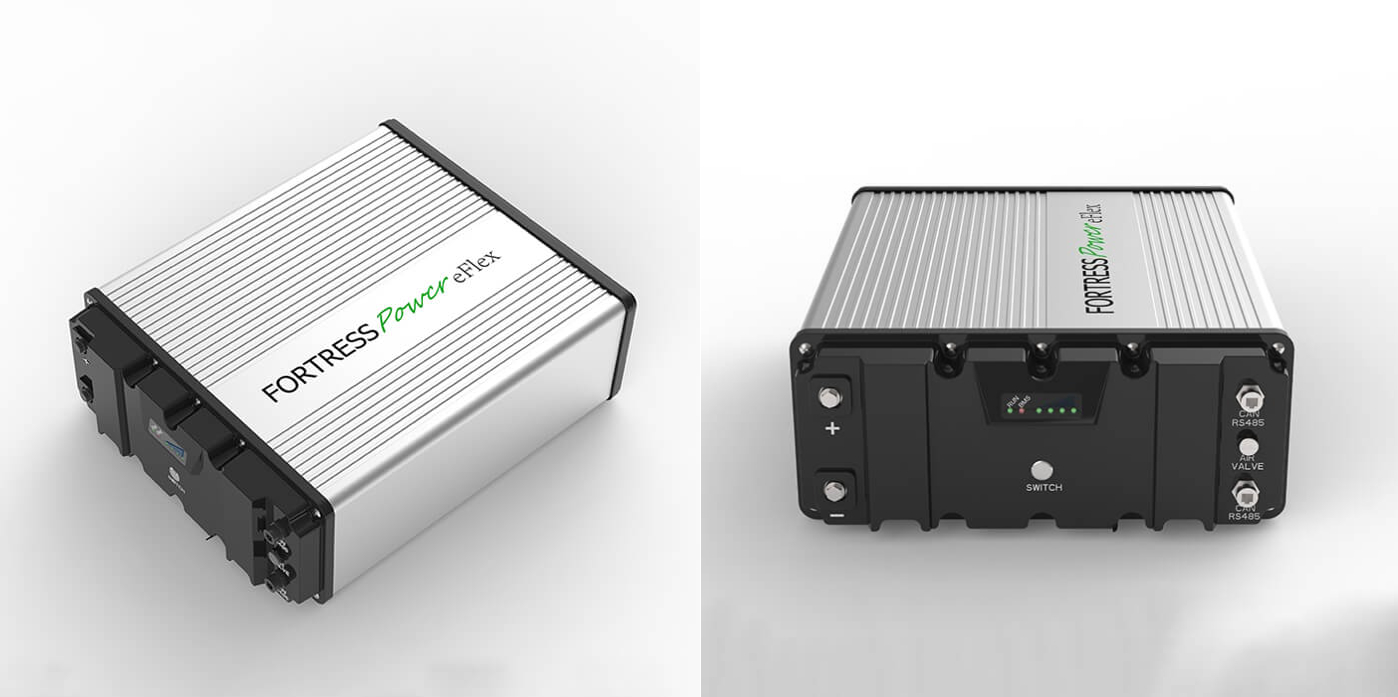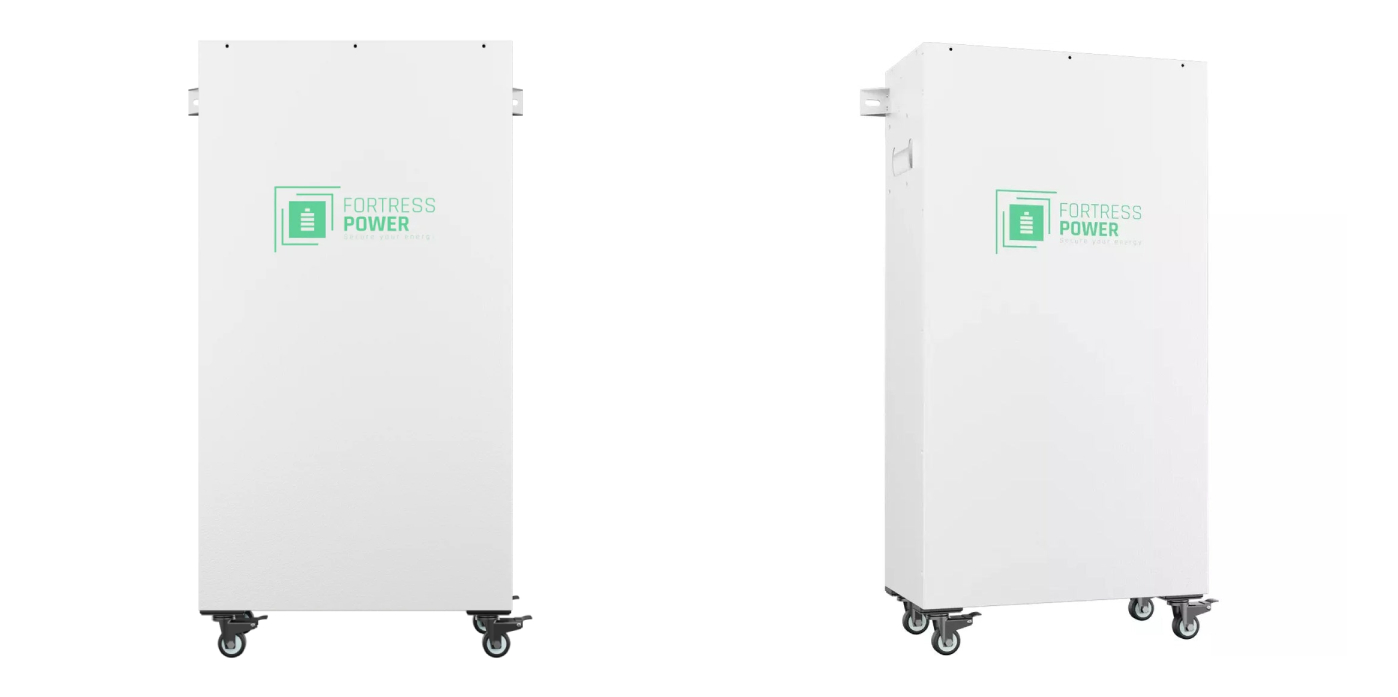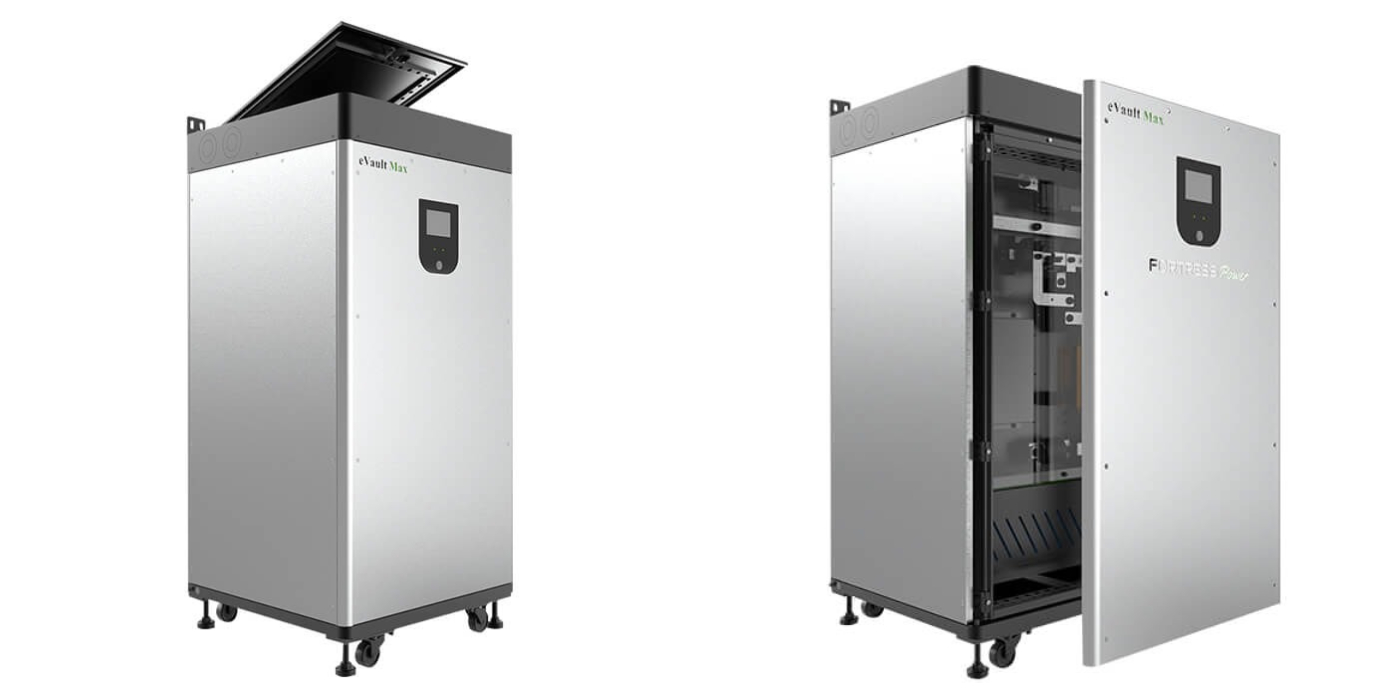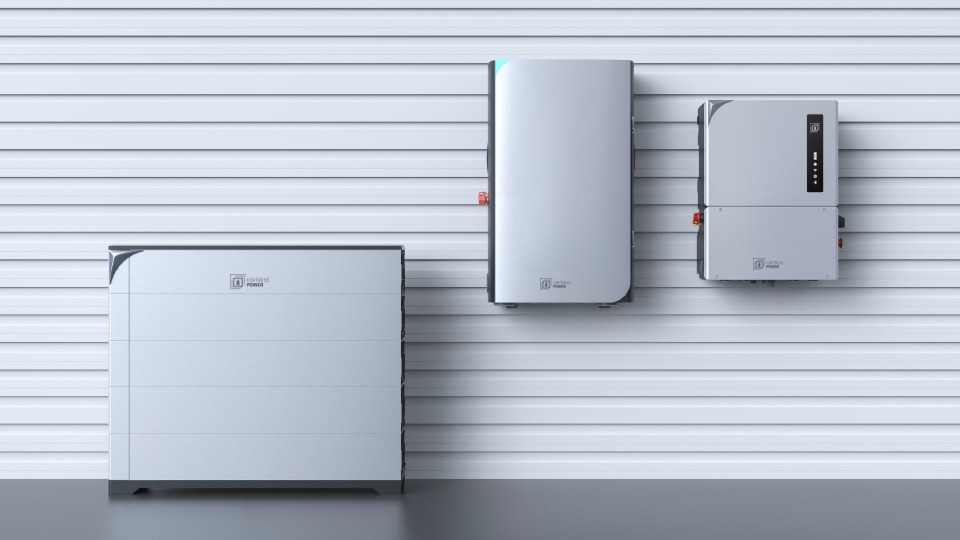Updated 1 week ago
Fortress Power batteries: expert overview
Written by
Ben Zientara
Find out how much a solar-plus-storage system costs for your specific home
If you’re looking for home energy storage, many installation companies will recommend Fortress Power.
Fortress Power is an American energy storage company that got its start in 2016, and is growing fast. The company's products are designed in the U.S. and assembled in Asia. According to our 2024 Solar Industry Survey, Fortress Power batteries are sold by about 18% of solar installers —more than twice as many as the year before.
Fortress Power offers a variety of products for home energy storage. Here’s a quick rundown of the products we’ll cover:
eFlex 5.4
LFP-10 Max
eVault Max 18.5 kWh
Avalon High Voltage ESS
Our take on Fortress Power batteries
Fortress Power makes robust, well-designed, and competitively-priced batteries. We recommend them for home or commercial backup power use.
The company’s new Avalon Energy Storage System is particularly interesting because of its maximum continuous output of 11.4 kilowatts (kW), solar integration, and smart circuit control. In addition, the Avalon battery comes with an impressive 15-year warranty, one of the best solar battery warranties in the industry.
Pros and cons of Fortress Power batteries and products
Pros
-
Use lithium iron phosphate (LFP) battery cells
-
Newest products include outdoor-rated enclosures
-
Avalon ESS has some exciting technology
-
Industry average pricing
Cons
-
Many products DC only, requiring an inverter
-
Warranty coverage isn’t as good as other brands
-
Fortress Power is a private company with no published financial data
There are many things to like about Fortress Power’s products, which come with industry-average pricing but include some unique and exciting features. The company’s products use great lithium iron phosphate (LFP) battery cells and outdoor-rated enclosures.
The Avalon ESS system offers modular, stackable batteries and a smart energy panel that can be used as a main service panel—essentially backing up your whole home with up to 200A of passthrough current. That’s a pretty big deal.
Unfortunately, there are also some drawbacks. People who already have solar panels won’t find a lot they can use here, as Fortress’ DC-coupled batteries require a separate inverter, making them best suited for a new solar-plus-storage installation.
Finally, the company’s warranties stipulate an 80% depth-of-discharge to achieve its promised 8,000-cycle life, meaning that 14.7 kWh battery stack in the Avalon ESS only has a usable capacity of 11.76 kWh if you want to keep the warranty alive. And as a private company, it’s difficult to get a read on Fortress Power’s long-term financial stability, meaning we can’t say whether they have what it takes to be around long enough to honor that 15-year Avalon warranty.
eFlex 5.4

Image source: Fortress Power
Fortress Power eFlex 5.4 specifications | |
|---|---|
Energy capacity | 5.4 kWh |
Max. continuous power output | 3 kW |
Approximate retail cost (pre-installation) | $2,495 ($460/kWh) |
Battery chemistry | Lithium iron phosphate |
Coupling | DC coupled |
Dimensions | 18” x 23” x 7.3” |
Weight | 108 lbs |
Life cycles | 8,000 at 80% depth of discharge |
Additional features | IP65 (outdoor-rated) wall-, floor-, or cabinet-mountable enclosure. Requires inverter for use in the home. |
Full datasheet | |
The first product in our roundup is the 5.4 kWh eFlex battery. This small wonder is a compact DC-coupled battery that’s easy to stack or rack mount for expansion of up to 30 modules in parallel for 162 kilowatt-hours (kWh) of storage. The eFlex is designed to fit inside Fortress Power’s DuraRack indoor/outdoor enclosure.
Important features of this battery include its UL 9540 and 9540A certifications, meaning it has been tested for fire resistance, and its IP65 dust and waterproof enclosure, allowing for outdoor use even in wet environments.
Note that although the eFlex is rated for outdoor use, its operating temperature range is only between 32 and 95 degrees Fahrenheit, so this is not a cold-climate battery unless it’s mounted in a DuraRack alongside a heater.
Ideal uses for the eFlex 5.4 kWh battery include home and commercial solar backup (when paired with a hybrid inverter), and mobile backup on vehicles, boats, and more.
The eFlex comes with a 10-year warranty with coverage for up to 8,000 charge-discharge cycles (as long as you don’t discharge the battery by more than 80% of its total capacity). The cycle life warranty protection decreases to 3,000 if the battery is discharged by 100% of its rated capacity.
When compared to other warranties in the home battery industry, the eFlex falls a bit short. The average is 10 years of coverage with 6,000 cycles at 100% depth of discharge. Furthermore, most battery warranties state that a battery will retain at least 70% of its ability to hold energy at the end of the warranty period. Fortress Power’s eFlex warranty does not state a remaining capacity at the conclusion of its warranty period.
LFP-10 Max

Image source: Fortress Power
Fortress Power LFP-10 Max specifications | |
|---|---|
Energy capacity | 10.24 kWh |
Max. continuous power output | 6 kW |
Approximate retail cost (pre-installation) | $4,750 ($460/kWh) |
Battery chemistry | Lithium iron phosphate |
Coupling | DC coupled |
Dimensions | 17.3” x 9.4” x 33.8” |
Weight | 210 lbs |
Life cycles | 6,000 at 80% depth of discharge |
Additional features | IP30 (indoor) floor-standing enclosure with casters. Requires inverter for use in the home. |
Full datasheet | |
The Fortress Power LFP-10 Max is the next step up in the product lineup. It removes some of the robustness of the eFlex series in favor of a purpose-built cabinet on casters that makes it easy to move around if necessary.
The cabinet is meant for indoor use only, with a maximum of two units in parallel. One benefit of the LFP-10 Max over the eFlex is its higher power output. At about 6 kW, the LFP-10 Max can power twice the amount of electrical appliances.
Unfortunately, the LFP-10 Max comes with a worse warranty than the eFlex. Both 5- and 10-year terms are available (with a slight difference in retail price), but the number of cycles allowed within the warranty period is just 6,000 at 80% depth of discharge, compared to the eFlex’s 8,000. The LFP-10 is also not UL 9540 certified to be fire resistant.
Like the eFlex, the LFP-10 Max can be used in residential and commercial backup situations, but only 2 of them can be installed together in parallel operation, limiting the maximum system capacity to 20.48 kWh.
eVault Max 18.5 kWh

Image source: Fortress Power
Fortress Power eVault Max 18.5 kWh specifications | |
|---|---|
Energy capacity | 18.43 kWh |
Max. continuous power output | 9.2 kW |
Approximate retail cost (pre-installation) | $9,999 ($540/kWh) |
Battery chemistry | Lithium iron phosphate |
Coupling | DC or AC coupled (inverter sold separately) |
Dimensions | 20.3” x 20.3” x 42.2” |
Weight | 520 lbs |
Life cycles | 8,000 at 80% depth of discharge |
Additional features | IP55 (outdoor) floor-standing enclosure with casters. Requires inverter for use in the home. |
Full datasheet | |
Last up in the DC-coupled side of the Fortress Power catalog is the eVault 18.5 kWh battery cabinet. Fortress Power likes to brag that this is “the largest single residential battery in the world!” They’re not wrong about that, with the eVault’s 18.43 kWh capacity just topping the 18 kWh Generac PWRcell M6.
In addition to its large capacity, the eVault can be expanded by up to 20 units in parallel, for a total capacity of a whopping 370 kWh. If you need to use that much energy storage for a residential application, you must have a HUGE house.
The eVault cabinet is outdoor rated at IP55, providing limited protection from dust and low-pressure water jets from any direction. This is the first of Fortress Power’s products that can withstand colder temperatures on its own, with the ability to discharge down to -4° F (although to recharge, it needs to be over 32° F). Like the smaller eFlex, the eVault system is UL 9540 and 9540A certified for fire resistance.
The eVault can do on- or off-grid backup power when paired with one of Fortress Power’s compatible inverter partners.
Considering the eVault can be assembled into a huge system, it is best for large residential or commercial applications, but for the right price, a single unit paired with a hybrid inverter is a great choice, too.
Avalon High Voltage ESS

Image source: Fortress Battery
Fortress Power Avalon High Voltage ESS specifications | |
|---|---|
Energy capacity | Expandable from 14.7 to 29.4 kWh |
Max. continuous power output | 7.6 - 11.4 kW (based on selected inverter) |
Approximate retail cost (pre-installation) | $17,950 for 11.4 kW, 19.6 kWh system ($920/kWh) |
Battery chemistry | Lithium iron phosphate |
Coupling | All-in-one system with the battery DC coupled to a hybrid solar inverter |
Dimensions | Avalon BMS and Battery Pack (4 modules): 43” x 34.72” x 10.96” Avalon Hybrid Inverter: 21.87” x 34.88” x 8.62” Avalon Smart Energy Panel: |
Weight | Avalon BMS and Battery Pack (4 modules): 392.4 lbs Avalon Hybrid Inverter: 89.6 lbs Avalon Smart Energy Panel: 55 lbs |
Life cycles | 8,000 at 80% depth of discharge |
Additional features | IP65 (outdoor) floor-standing enclosure with casters |
Full datasheet | |
We’ve arrived at Fortress Power’s latest flagship product: the Avalon ESS (Energy Storage System). This ecosystem of related products includes a stackable modular battery bank, a hybrid solar inverter, and the Avalon Smart Energy Panel.
The system's components work together to store DC solar power from photovoltaic modules, serve a home with AC electricity, and selectively control backup circuits when the home relies on the energy stored in the batteries.
Fortress Power provides two versions of the Avalon hybrid inverter with either 7.6 kW or 11.4 kW of power output. The inverters can be paired with two full battery stacks for up to 58.8 kWh of storage on a single inverter.The Smart Energy Panel can control up to six circuits (aka “ electrical loads”), and a practice called “load shedding” can be used to turn off selected low-priority circuits, either when the battery capacity drops below a certain level or during specified times. Load shedding can save homeowners money by preventing high-power appliances like EV chargers and clothes dryers from being activated during peak demand times when electricity is expensive.
The battery pack comes with active heating and cooling, which means it can withstand cold temperatures, charging when the thermometer is as low as 14° F and discharging all the way down to -4° F.
Importantly, the Avalon system comes with a 15-year (or 8,000 cycle) warranty on the battery components, along with 10 years of coverage for the inverter and 5 years for the Smart Energy Panel. The battery coverage matches the 15 years provided by the popular Enphase IQ 5P.
How much do Fortress Power batteries cost in 2024?
Fortress Power batteries come at various prices based on their components and features. The DC coupled batteries are cheaper on a dollars-per-kWh basis because they require an external inverter, whereas the Avalon ESS includes a hybrid inverter, making it more expensive.
Here’s a quick rundown of estimated retail prices:
Model | Price | Capacity | Cost per kWh | DC- or AC-coupled |
|---|---|---|---|---|
eFlex 5.4 | $2,495 | 5.4 kWh | $460 | DC |
LFP-10 Max | $4,750 | 10.24 kWh | $460 | DC |
eVault Max | $9,999 | 18.43 kWh | $540 | DC |
Avalon ESS | $17,950 | 19.6 kWh | $920 | AC hybrid |
These prices compare favorably to the rest of the home battery industry, where the average retail cost is around $490/kWh for DC-coupled batteries and $890/kWh for AC-coupled batteries.
Note that we said retail prices there. Prices for batteries purchased through a solar installer will be different, and the numbers above don’t include installation costs.
Additionally, all of the Fortress Power models above qualify for the federal clean energy tax credit and other solar battery incentives. These can bring down the costs considerably.
Final thoughts: Are Fortress Power batteries right for you?
If you’re shopping for home battery backup or a home solar system, and an installer recommends Fortress Power products, you can rest assured that you’re getting a quality battery from an established company.
For people who already have solar panels, Fortress Power’s DC batteries are a great match to hybrid inverters from companies like Sol-Ark, Outback, and Magnum. If you don’t yet have solar panels, the all-in-one Avalon ESS system is a fine choice to install alongside a new solar system.
Still, when it comes to home battery backup, Fortress Power doesn’t make the list of our top choices for the best solar batteries. This is mostly because the company is privately held, meaning we can’t see its finances and know for sure that it is profitable and growing.
Ben Zientara is a writer, researcher, and solar policy analyst who has written about the residential solar industry, the electric grid, and state utility policy since 2013. His early work included leading the team that produced the annual State Solar Power Rankings Report for the Solar Power Rocks website from 2015 to 2020. The rankings were utilized and referenced by a diverse mix of policymakers, advocacy groups, and media including The Center...
Learn more about Ben Zientara